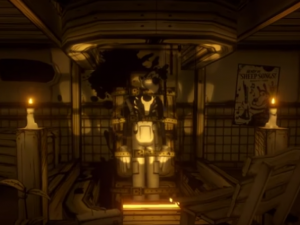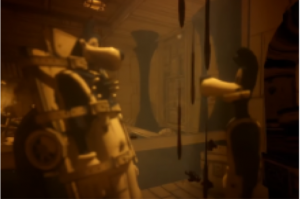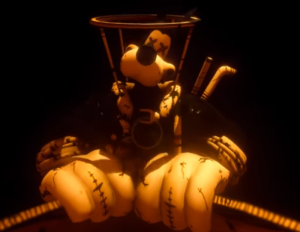The origins and development of the animated voice of cartoons provide a compelling way to understand the conflation of animals with the animated language. The animal body and the human body become intertwined through anthropomorphic cartoon body. The body of the anthropomorphic animal is an ambiguous space augmenting the inherent play associated with these bodies. The inclusion of the anthropomorphic animal provides a specific code of regulation and governing disguised as playful. I will examine the regulatory relationship between animals and animation by looking at how the cartoon character Boris in the video game Bendy and the Ink Machine (TheMeatly Games, 2017) becomes a figure of commodification and explicit capitalistic regulation.
Bendy and the Ink Machine is set in the fictional Joey Drew Studies where the only playable character, Henry, must escape while avoiding being killed by corporeal cartoon characters. This video game is shown from the first person perspective and has a distinct early cartoon aesthetic which situates these characters during the early and mid-twentieth century. While Bendy and the Ink Machine features both humanoid and animal characters, the latter are all voiceless. The most notably voiceless body is that of Boris, an anthropomorphic dog who repeatedly appears throughout the game. Boris’s voiceless anthropomorphic body is used as a space of production.
While animation’s use of the voice was initially celebrated for its technological advance, the cinematic voice also has a problematic and hidden connection to the contorting of the black body displayed on the screen. There is a particular type of voice, known as the ‘black voice,’ that early animated cartoons mirrored. In Stealing the Show: African American Performers and Audiences in the 1930s Hollywood (2016), Miriam J. Petty identifies and defines the ‘black voice’ when discussing Lincoln Perry’s problematic stardom as Stepin Fetchit in the 1930s. Perry/Fetchit’s voice was how he entered Hollywood. His voice also limited the roles he and other black actors played to the uneducated, unintelligible trickster and other “amusing” caricatures of the black identity. The ‘black voice’ is a voice with oppressive origins limiting black actors to stereotypical and problematic roles (Petty 2016). The draw of his voice and nonsense words he produced mirrored his slumped and lazy postures reinforcing the images of blackness perpetuated by minstrelsy. Perry/Fetchit’s ‘black voice’ also extended into cartoons such as Disney’s Broken Toys (1935), where Perry/Fetchit appears in animated form as a bent marionette. The inclusion of the ‘black voice’ in Broken Toys exemplifies how this voice became an explicit part of the soundscape of animation. The ‘black voice’ created a space for black actors to enter Hollywood. However, this space was limited and demanded an othering of black bodies.
The ‘black voice’ in Bendy and the Ink Machine is removed from the anthropomorphic animal cartoons creating voiceless bodies. While Boris is not a black body, his anthropomorphic animal body occupies the space of the marginalized other. His otherness is augmented not only by the physical appearance of his body but also how his body is used throughout the game. Unlike the talkative antagonistic human cartoons (such as Alice Angel), Boris never speaks, and these highlights his body as a site of labor. His animal qualities allow his body to become a site of production for the progression of the game.

Boris’s lack of voice signifies the ability of his body to be contorted. Initially, Boris is one of the few characters who does not attempt to kill the player/Henry. As the game progresses, the player/Henry interacts with four voiceless clones of Boris. The first body the player sees is the dissected and open body of a dead Boris (see figure 1). This body is not just displayed. It is shown as a site of commodification. Boris’s diegetic body contains a tool (a wrench) Henry needs in order to complete the first objective. Immediately, Boris’s body is a space for the production of labor. Since Boris’s exposed and static body is the first corporeal body Henry/the player sees, the immediate objectification of the animated body juxtaposed to the poster version of Boris becomes the first sinister moment. Boris then reappears in the second chapter of the game, silently accompanying the player/Henry. The first clone (the dead Boris) and the second clone (the live Boris) are juxtaposed prior to the third iteration of Boris (the antagonistic Boris) (see figure 2).

This confrontation of the live Boris with the dissected Boris places the contorting of his body as the focus of both the player’s Henry’s gaze as well as Boris’s gaze. While the prior two clones of Boris have aided the player both passively and actively, the third clone is an antagonistic Boris, one who has been modified with machines by a talkative body (Alice Angel). The modification of Boris transforms his body into actual machinery.

The fourth version of Boris is one similar to the second iteration of Boris, but without the same unquestioned following the player/Henry (see figure 3). The removal of Boris’s voices forces the player to create distance between the displayed body and their romanticized origin story. The body of the animal, especially the anthropomorphic animal, exists within early animation allowing for the normalization of the commodification of the bodies of marginalized others. While the animated anthropomorphic bodies initially allowed for the disguised regulation of biological bodies, Boris makes this regulation visible through his lack of voice and the explicit contorting and repetition of his body throughout the game.
Isabelle Williams received her BA in English from University of California, Davis and is currently pursuing her Master’s in Film Studies from Dodge College of Film and Media Arts, Chapman University. Isabelle’s research focuses on how the black body is displayed on screen, and particularly on the intersection between animation and blackface minstrelsy. She is also interested in the practices and resistive potential of video games in relationship to the displayed black body.
References
Petty, Miriam (2016). “Lincoln Perry’s ‘Problematic Stardom’: Stepin Fetch Steals the Shoat.” In Stealing the Show: African American Performers and Audiences in the 1930s Hollywood, Oakland: University of California Press.
Sammond Nicholas (2015). Birth of an Industry: Blackface Minstrelsy and the Rise of American Animation, Durham: Duke University Press.
